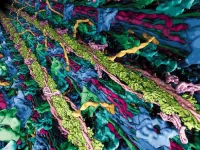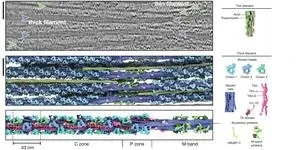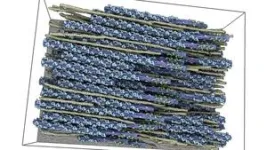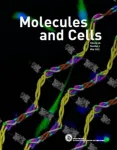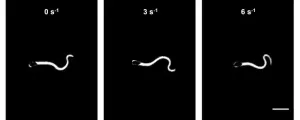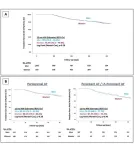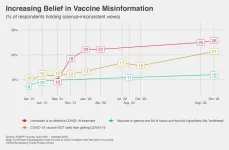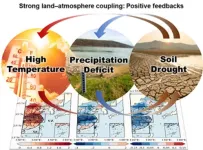(Press-News.org) Atrial fibrillation, heart failure and stroke – hypertrophic cardiomyopathy can lead to many serious health conditions and is a major cause of sudden cardiac death in people younger than 35. „The heart muscle is a central engine of the human body. Of course, it is easier to fix a broken engine, if you know how it is built and how it functions”, says Stefan Raunser. “At the beginning of our muscle research we have successfully visualized the structure of the essential muscle building blocks and how they interact using electron cryo-microscopy. However, these were static images of proteins taken out of the living cell. They only tell us little about how the highly variable, dynamic interplay of muscle components moves the muscle in its native environment”, says Raunser.
Throuh thick and thin
Skeletal and heart muscles contract upon the interaction of two types of parallel protein filaments in the sarcomere: thin and thick. The sarcomere is subdivided in several regions, called zones and bands, in which these filaments are arranged in different ways. The thin filament consists of F-actin, troponin, tropomyosin, and nebulin. The thick filament is formed of myosin, titin and myosin binding protein C (MyBP-C). The latter can form links between the filaments, whereas myosin, the so-called motor protein interacts with the thin filament to generate force and muscle contraction. Alterations in the thick filament proteins are associated with muscle diseases. A detailed picture of the thick filament would be of immense importance for developing therapeutical strategies to cure these diseases, but has been missing so far.
Milestones in muscle research
“If you want to fully understand how the muscle works on the molecular level, you need to picture its components in their natural environment - one of the biggest challenges in biological research nowadays that cannot be tackled by traditional experimental approaches”, says Raunser. To overcome this obstacle his team developed an electron cryo-tomography workflow specifically tailored to the investigation of muscle samples: The scientists flash-freeze mammalian heart muscle samples, produced by the Gautel group in London, at a very low temperature (- 175 °C). This preserves their hydration and fine structure and thus their native state. A focused ion beam (FIB milling) is then applied to thin out the samples to an ideal thickness of around 100 nanometers for the transmission electron microscope, which acquires multiple images as the sample is tilted along an axis. Finally, computational methods reconstruct a three-dimensional picture at high resolution. In recent years, Raunser’s group successfully applied the customized workflow, resulting in two recent groundbreaking publications: They produced the first high-resolution images of the sarcomere and of a so far nebulous muscle protein called nebulin. Both studies provide unprecedented insights into the 3D organization of muscle proteins in the sarcomere, e. g. how myosin binds to actin to control muscle contraction and how nebulin binds to actin to stabilize it and to determine its length.
Completing the painting
In their current study the scientists produced the first high-resolution image of the cardiac thick filament spanning across several regions in the sarcomere. “With 500 nm length this makes for the longest and biggest structure ever resolved by cryo-ET”, says Davide Tamborrini from the MPI Dortmund, first-author of the study. Even more impressive are the newly gained insights into the thick filament’s molecular organization and thus into its function. The arrangement of the myosin molecules depends on their position in the filament. The scientists suspect, that this allows the thick filament to sense and process numerous muscle-regulating signals and thus to regulate the strength of muscle contraction depending on the sarcomere region. They also revealed how titin chains run along the filament. Titin chains intertwine with myosin, acting as a scaffold for its assembly and probably orchestrating a length-depending activation of the sarcomere.
“Our aim is to paint a complete picture of the sarcomere one day. The image of the thick filament in this study is ‘only’ a snapshot in the relaxed state of the muscle. To fully understand how the sarcomere functions and how it is regulated, we want to analyze it in different states e. g. during contraction“, says Raunser. Comparison with samples from patients with muscle disease will ultimately contribute to a better understanding of diseases like hypertrophic cardiomyopathy and to the development of innovative therapies.
END
Breakthrough discovery sheds light on heart and muscle health
Scientists shoot first true-to-life 3D image of the thick filament of mammalian heart muscle
2023-11-01
ELSE PRESS RELEASES FROM THIS DATE:
Chemical process makes peptide acquire structure similar to amyloid plaques found in neurodegenerative diseases
2023-11-01
Peptides are biomolecules formed when two or more amino acids that perform key functions in the human organism, such as hormones, neurotransmitters, painkillers and antibiotics, bind together. For this reason, they are much studied and used by the pharmaceutical industry, for example.
A study conducted by scientists in the Department of Biophysics at the Federal University of São Paulo's Medical School (EPM-UNIFESP) in Brazil identified significant changes in the physicochemical properties of peptides during a spontaneous process of chemical change called pyroglutamination.
Pyroglutamination is a modification resulting from spontaneous conversion ...
Elsevier partners with the Korean Society for Molecular and Cellular Biology to publish Molecules and Cells
2023-11-01
Amsterdam, November 1, 2023 – The Korean Society for Molecular and Cellular Biology (KSMCB), one of the largest and most prominent academic societies in the field of life sciences in Korea, and Elsevier, a leader in information and analytics for customers across the global research and health ecosystems, are pleased to announce a new partnership to publish Molecules and Cells, the flagship journal of KSMCB. This English-language publication will be hosted on Elsevier’s industry-leading online platform of peer-reviewed literature, ScienceDirect, beginning January 1, 2024. Continuing ...
Do physical connections improve the control and performance of robot swarms?
2023-11-01
In nature, swarms can accomplish amazing things. Schools of fish can more efficiently find food and migrate. Flocks of birds can confuse predators. Bees, ants, and termites can work together to feed, defend and build their colonies.
Robotics researchers have long been trying to harness this ability to explore environments, capture objects and build structures using robot swarms.
“But the problem of how do we efficiently control all those robots is still unsolved,” says David Saldaña, an assistant professor ...
Dr. Jennifer Lotz appointed Space Telescope Science Institute Director
2023-11-01
The Association of Universities for Research in Astronomy (AURA) is pleased to announce the appointment of Dr. Jennifer Lotz as the Director of the Space Telescope Science Institute (STScI). Dr. Lotz will begin her five-year appointment as STScI Director starting February 12, 2024. Previously, Dr. Lotz was the Director of the International Gemini Observatory which is operated by NSF’s NOIRLab, and managed by AURA.
“Dr. Lotz is a science driven, accomplished leader,” said Dr. Matt Mountain, President of AURA, which manages STScI on behalf of NASA. “Jen’s passion for the Institute’s mission, to enable the ...
Sperm adjust their swimming style to adapt to fluctuating fluid conditions
2023-11-01
Sperm can modulate their energetics by regulating their flagellar waveform—how the sperm oscillate their tails—in order to adapt to varying fluid environments, potentially optimizing their motility and navigation within the reproductive tract. This research is reported in a study publishing November 1 in the journal Cell Reports Physical Science.
“Our approach allowed us to investigate how variations in viscosity and shear rates affect sperm behavior at the single-cell level, which was not possible using traditional methods,” says senior study author Reza Nosrati of Monash University.
Biochemical and biophysical cues within the reproductive ...
Women with atrial fibrillation significantly benefit from pulsed field ablation procedures
2023-11-01
Women with atrial fibrillation (AF) undergoing a procedure called pulsed field ablation (PFA) have just as good outcomes as men with AF undergoing the same procedure, according to a large-scale international study led by the Icahn School of Medicine at Mount Sinai.
This study is the first to compare sex outcomes for AF patients undergoing PFA, which is a new technology and the latest ablation modality that can be used to restore a regular heartbeat. The results also show PFA is safe and just as effective for men as for women. Findings were published October 5 in JAMA Cardiology.
“These results are important, as ...
Prevalence, awareness, and treatment of elevated LDL cholesterol in adults, 1999-2020
2023-11-01
About The Study: Although the prevalence of severely elevated low-density lipoprotein cholesterol (LDL-C) has declined, 1 in 17 U.S. adults still have LDL-C levels of 160 to 189 mg/dL and 1 in 48 adults have LDL-C levels of 190 mg/dL or greater. Among those with an LDL-C of 190 mg/dL or greater, 1 in 4 are unaware and untreated, with a higher proportion for an LDL-C of 160 to 189 mg/dL. These gaps disproportionately affect non-Hispanic Black, Hispanic, and socioeconomically disadvantaged persons, contributing to disparities in outcomes.
Authors: Salim S. Virani, M.D., Ph.D., of Aga Khan University in Karachi, Pakistan, ...
Adverse life experiences and brain function
2023-11-01
About The Study: In this meta-analysis of 83 neuroimaging studies of adversity exposure and brain function, prior adversity exposure was associated with altered adult brain reactivity to diverse challenges. These results might better identify how adversity diminishes the ability to cope with later stressors and produces enduring susceptibility to mental health problems.
Authors: Niki Hosseini-Kamkar, Ph.D., of the Royal Ottawa Hospital in Ottawa, Ontario, Canada, is the corresponding author.
To access the embargoed ...
Vaccine confidence falls as belief in health misinformation grows
2023-11-01
PHILADELPHIA – Americans have less confidence in vaccines to address a variety of illnesses than they did just a year or two ago, and more people accept misinformation about vaccines and Covid-19, according to the latest health survey from the Annenberg Public Policy Center (APPC) of the University of Pennsylvania.
The survey conducted October 5-12, 2023, with a panel of over 1,500 U.S. adults, finds that the number of Americans who think vaccines approved for use in the United States are safe dropped to 71% from 77% in April 2021. The percentage of adults who don’t think vaccines approved in the U.S. are safe grew to 16% from ...
How the relationship between the land and atmosphere facilitated the persistence of eastern China’s extreme weather and climate in summer 2022?
2023-11-01
Extreme weather and climate events, such as droughts, heatwaves, and rainstorms, pose serious threats to human health, agricultural production, and energy supplies. These events often occur at the same time, and such "compound extreme events" can cause far more damage than any one single event. Climate scientists from the research group of Prof. Aihui Wang from the Institute of Atmospheric Physics, Chinese Academy of Sciences, Beijing, China, argue in a new study that land–atmosphere coupling (the coupling ...
LAST 30 PRESS RELEASES:
Numbers in our sights affect how we perceive space
SIMJ announces global collaborative book project in commemoration of its 75th anniversary
Air pollution exposure and birth weight
Obstructive sleep apnea risk and mental health conditions among older adults
How talking slows eye movements behind the wheel
The Ceramic Society of Japan’s Oxoate Ceramics Research Association launches new international book project
Heart-brain connection: international study reveals the role of the vagus nerve in keeping the heart young
Researchers identify Rb1 as a predictive biomarker for a new therapeutic strategy in some breast cancers
Survey reveals ethical gaps slowing AI adoption in pediatric surgery
Stimulant ADHD medications work differently than thought
AI overestimates how smart people are, according to HSE economists
HSE researchers create genome-wide map of quadruplexes
Scientists boost cell "powerhouses" to burn more calories
Automatic label checking: The missing step in making reliable medical AI
Low daily alcohol intake linked to 50% heightened mouth cancer risk in India
American Meteorological Society announces Rick Spinrad as 2026 President-Elect
Biomass-based carbon capture spotlighted in newly released global climate webinar recording
Illuminating invisible nano pollutants: advanced bioimaging tracks the full journey of emerging nanoscale contaminants in living systems
How does age affect recovery from spinal cord injury?
Novel AI tool offers prognosis for patients with head and neck cancer
Fathers’ microplastic exposure tied to their children’s metabolic problems
Research validates laboratory model for studying high-grade serous ovarian cancer
SIR 2026 delivers transformative breakthroughs in minimally invasive medicine to improve patient care
Stem Cell Reports most downloaded papers of 2025 highlight the breadth and impact of stem cell research
Oxford-led study estimates NHS spends around 3% of its primary and secondary care budget on the health impacts of heat and cold in England
A researcher’s long quest leads to a smart composite breakthrough
Urban wild bees act as “microbial sensors” of city health.
New study finds where you live affects recovery after a hip fracture
Forecasting the impact of fully automated vehicle adoption on US road traffic injuries
Alcohol-related hospitalizations from 2016 to 2022
[Press-News.org] Breakthrough discovery sheds light on heart and muscle healthScientists shoot first true-to-life 3D image of the thick filament of mammalian heart muscle
